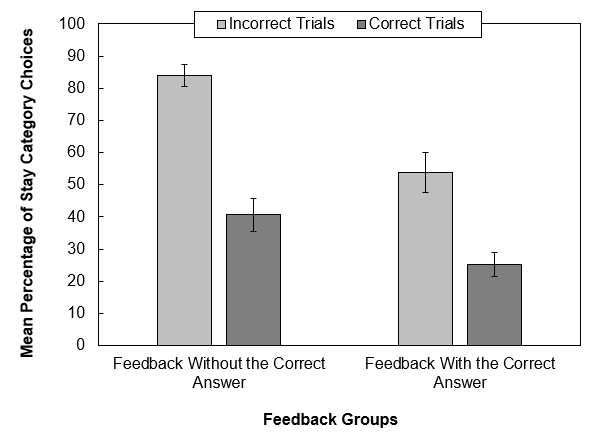Imagine you are preparing for a geology exam that will test your ability to identify different types of rocks. You have a lot of examples to study, but you are not sure how to organize them. Should you study one category at a time, studying several examples of obsidian and then several examples of peridotite? Or should you mix them up, studying one example of obsidian, then one peridotite, and then one gneiss? How do you decide the order in which to study?
In our paper published in the Psychonomic Society journal Memory & Cognition, Sarah “Uma” Tauber and I investigated how students choose to study different types of rocks. Previous studies have shown that students tend to study examples from the same category grouped together, and they often think that is the best way to learn. However, many of these studies explored students’ study decisions when reading or reviewing categories. We wanted to explore a different way to study: completing practice problems.

In multiple experiments, students learned to categorize ten types of rock by completing practice problems. As seen in the figure above, students were shown an image of a rock and were asked to classify it into the correct category. Then, they received feedback on their answer (i.e., Correct! or Incorrect!) and decided what type of category they wanted to practice next.
Students could either stick with the same type of rock they just studied or switch to a different type of rock. For example, after seeing an obsidian rock, they could either choose another obsidian rock or a random rock from another group. They repeated this process until they chose to take the final test on all the rock types they had learned.
Exploring Students’ Study-Order Decisions
We were most interested in students’ study order choices. Did they prefer to study one type of rock at a time, or did they mix them up? On average, students tended to stay within a category as they studied (i.e., grouping categories together). However, as shown in the figure below, we found that students’ choices depended on whether they got the previous problem right or wrong. If they got it wrong, they were more likely to stick with the same rock type and try another problem. In fact, in one experiment, getting a problem wrong made students up to 47 times more likely to stay with the same rock type compared to getting a problem right. On the other hand, if they got it right, they were more likely to switch to a different rock type and move on to a new category.
We also asked students why they made these choices. Students confirmed that they often stayed with the same rock type after an error because they felt the need for more practice, and students often switched to a new rock type after a correct answer because they felt they knew it well enough.

The Role of Feedback in Study-Order Decisions
Interestingly, students also reported that they often stayed with the same rock type after an error because they wanted to know what the correct answer was. So, in a follow-up experiment, we manipulated the feedback students received. Some students received feedback telling them they were right or wrong and what the correct answer was, and others received feedback telling them if they were right or wrong, but not the correct answer.
The results showed that students who received feedback with the correct answer were more likely to switch to a different rock type than students who did not get feedback with the correct answer. As seen in the graph below, this outcome was especially true when students made errors. Students who did not get the correct answer during feedback often said that they chose to continue studying the same category after an error because they wanted to know what the correct answer was by trying again. However, students who got the correct answer during feedback already knew the answer to their error, and fewer students decided to study another example of the category to figure out their mistakes.

The Role of Familiarity in Study-Order Decisions
Our findings suggest that getting practice problems correct or incorrect influences students’ study order choices. Thus, factors that influence practice performance should also impact students’ decisions. In our final experiment, we influenced practice performance by manipulating familiarity. Before they started the practice problems, some students got a preview of the different rock types, and some students did not get any preview. We found that the preview made a difference. As we expected, the students who saw the preview did better on the practice problems than the students who did not see the preview. The students who saw the preview also tended to switch to different types of rocks more often than the students who did not see the preview.
Implications for Students and Educators
When students are familiar with the content, solve practice problems, and get feedback, they can evaluate their knowledge and decide which categories they need to study. Practice problems help them determine which categories are the most challenging for them and where to spend their time. Practice problems also lead to students switching between categories more often, which can be beneficial to learning in some cases. As the fall term approaches, students and educators alike should think about how they can incorporate practice problems and feedback into their courses. When students practice classifying important categories and receive feedback, they can make more strategic and effective study choices.
